 W
W1 Aurigae is the original name for a star now in the constellation Perseus. It was the first entry in John Flamsteed's catalogue of stars in Auriga. When Eugène Joseph Delporte drew up simplified boundaries for the constellations on behalf of the International Astronomical Union in 1930, 1 Aurigae ended up over the border in Perseus. To avoid confusion, the star may instead be referred to by its Harvard Revised catalogue number, HR 1533.
 W
W1 Delphini is a shell star with stable emission lines in the constellation of Delphinus. 1 Delphini consists of three components. 1 Delphini A, the brightest of them, has a magnitude of 6.1; 1 Delphini B located around 0.9 arcsecconds from 1 Delphini A has an apparent magnitude of 8.1; and 1 Delphini C located much farther away at around 17 arcseconds from component A is the faintest with a magnitude of around 14. Due to the stability of the emission lines data from 1 Delphini has been used for developing models of shell stars and Be stars.
 W
W1 Geminorum is a star in the constellation Gemini. Its apparent magnitude is 4.15.
 W
W1 Persei is an eclipsing binary star in the constellation Perseus. Its uneclipsed apparent magnitude is 5.49. The binary star consists of two B2 type main-sequence stars in a 25.9 day eccentric orbit. The stars are surrounded by a faint cloud of gas visible in mid-infrared, although whether they are the origin of the gas or simply passing through it is unclear.
 W
W2 Aurigae is a possible binary star system in the northern constellation of Auriga. This object is visible to the naked eye as a faint, orange-hued star with an apparent visual magnitude of +4.79. It forms an attractive four-star asterism when viewed in a low power eyepiece, together with the nearby HIP 22647 and another very loose visual pair, HIP 22776 and HIP 22744, all above magnitude 8. 2 Aurigae is moving closer to the Earth with a heliocentric radial velocity of −17 km/s.
 W
W2 Lacertae is a binary star in the constellation of Lacerta. With an apparent magnitude of about 4.5, it is faintly visible to the naked eye. Its parallax, measured by the Hipparcos spacecraft, is 5.88 milliarcseconds, corresponding to a distance of about 550 light years. It is projected against the Lacertae OB1 stellar association to the northeast of the main concentration of stars, but it is likely to be a foreground object.
 W
W3 Andromedae, abbreviated 3 And, is a single star in the northern constellation of Andromeda. 3 Andromedae is the Flamsteed designation. It is visible to the naked eye with an apparent visual magnitude of 4.64. The distance to this star, as determined from an annual parallax shift of 18 mas, is 181 light years. It is moving closer to the Earth with a heliocentric radial velocity of −35 km/s, and has a relatively large proper motion, traversing the celestial sphere at 0.236″·yr−1.
 W
W3 Equulei is a single star located in the small northern constellation of Equuleus. It is faintly visible to the naked eye at an apparent visual magnitude of 5.6. Based upon an annual parallax shift of 4.24 mas, 3 Equulei is roughly 770 light-years distant from Earth, give or take an 80 light-year margin of error. At that distance, the apparent brightness of the star is diminished by 0.15 in visual magnitude because of extinction from interstellar gas and dust.
 W
W4 Scorpii is a single star in the southern zodiac constellation of Scorpius. With an apparent visual magnitude of +5.6, it is dimly visible to the naked eye under good viewing conditions. The distance to this star can be estimated from its annual parallax shift of 7.99±0.77 mas, which yields a value of around 410 light years. It is moving closer to the Sun with a heliocentric radial velocity of −29 km/s and will reach perihelion in about two million years at an estimated distance of 280 ly (86 pc).
 W
W5 Lacertae is a spectroscopic binary in the constellation Lacerta. Its apparent magnitude is 4.36.
 W
W7 Sagittarii is a massive star in the southern zodiac constellation of Sagittarius which is located in the Lagoon Nebula, although multiple sources have considered it a foreground star. It is a dim star but visible to the naked eye with an apparent visual magnitude of 5.37. The distance to this star can be determined from the annual parallax shift of 3.02±0.28 mas, yielding a value of roughly 1,100 light years. It is moving closer to the Sun with a heliocentric radial velocity of −11 km/s.
 W
W9 Aurigae is a star system in Auriga (constellation). It has an apparent magnitude of about 5, making it visible to the naked eye in many suburban skies. Parallax estimates made by the Hipparcos spacecraft put it at about 85.7 light-years from the solar system.
 W
W9 Vulpeculae is a star in the northern constellation of Vulpecula, located about 550 light years away based on parallax. It is visible to the naked eye as a faint, blue-white hued star with a baseline apparent visual magnitude of 5.00. The star is moving further from the Earth with a heliocentric radial velocity of +5 km/s.
 W
W10 Aquilae is a star in the equatorial constellation of Aquila. 10 Aquilae is the Flamsteed designation. It has an apparent visual magnitude of 5.9 and thus is a faint star that is just visible to the naked eye in dark skies. The brightness of this star is diminished by 0.17 in visual magnitude from extinction caused by interstellar gas and dust. Based on an annual parallax shift of 13.45 mas, the distance to this star is around 240 light-years.
 W
W11 Camelopardalis is a single star in the northern circumpolar constellation of Camelopardalis, located around 710 light years away from the Sun as determined by parallax. It has the variable star designation BV Camelopardalis; 11 Camelopardalis is the Flamsteed designation. This object is visible to the naked eye as a faint, blue-white hued star with a baseline apparent visual magnitude of +5.22. It forms a double star with 12 Camelopardalis, which is only 3 arcminutes away.
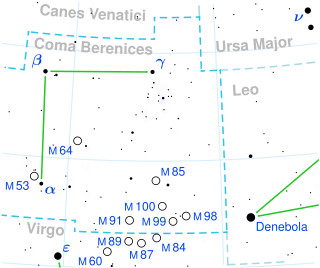 W
W11 Comae Berenices is a binary star system in the northern constellation of Coma Berenices, located in the sky, east and slightly north of Denebola in Leo, but not nearly as far east as ε Virginis in Virgo. It is about a degree from the elliptical galaxy M85 and two degrees north of the spiral galaxy M100. Based upon an annual parallax shift of 10.7104 mas, the star is located 305 light years away from the Sun. It is visible to the naked eye as a faint, orange-hued star with an apparent visual magnitude of 4.72. This body is moving away from the Sun with a heliocentric radial velocity of +44 km/s.
 W
W12 Boötis is a spectroscopic binary in the constellation Boötes. It is approximately 122 light years from Earth.
 W
W12 Camelopardalis is a binary star in the northern circumpolar constellation of Camelopardalis, located 700 light years away from the Sun as determined from parallax measurements. It forms a double star with 11 Camelopardalis, which is only 3 arcminutes away. The system has the variable star designation BM Camelopardalis; 12 Camelopardalis is the Flamsteed designation. It is just visible to the naked eye, appearing as a dim, orange-hued star with an apparent visual magnitude of 6.08. The system is moving closer to the Earth with a heliocentric radial velocity of −2 km/s.
 W
W12 Comae Berenices is a binary star system in the northern constellation of Coma Berenices. It is the brightest member of the Coma Cluster and is visible to the naked eye with an apparent visual magnitude of 4.80. Although listed as a suspected variable star, there is no photometric evidence of it being variable in luminosity. However, the radial velocity was found to be variable, as announced by W. W. Campbell in 1910. The first orbital solution was published by Vinter Hansen in the 1940s. It is a double-lined spectroscopic binary with an orbital period of 396.5 days and an eccentricity of 0.566.
 W
W12 Vulpeculae is a star in the northern constellation of Vulpecula, located approximately 630 light years away based on parallax. It has the variable star designation V395 Vul; 12 Vulpeculae is the Flamsteed designation. This object is visible to the naked eye as a faint, blue-white hued star with a baseline apparent visual magnitude of 4.96. It is moving closer to the Earth with a heliocentric radial velocity of -25 km/s.
 W
W13 Vulpeculae is a blue giant with a stellar classification of class B9.5III in the northern constellation Vulpecula. It is visible to the naked eye as a faint, blue-white hued star with an apparent visual magnitude of 4.57 and it is approximately 335 light years away from the Sun based on parallax. The star is radiating 180 times the luminosity of the Sun from its photosphere at an effective temperature of 8,801 K.
 W
W15 Vulpeculae is a variable star in the northern constellation of Vulpecula, located approximately 236 light years away based on parallax. It has the variable star designation NT Vulpeculae; 15 Vulpeculae is the Flamsteed designation. It is visible to the naked eye as a faint, white-hued star with a typical apparent visual magnitude of 4.66. This object is moving closer to the Earth with a heliocentric radial velocity of −26 km/s.
 W
W16 Lyncis is a star in the constellation Lynx. It is positioned next to the western constellation border with Auriga, and is also known as Psi10 Aurigae, which is Latinized from ψ10 Auriga. The star has a white hue and is visible to the naked eye with an apparent visual magnitude of 4.90. The distance to this object is approximately 241 light years based on parallax, but it is drifting closer to the Sun with a radial velocity of −12 km/s. It has an absolute magnitude of 0.56.
 W
W17 Lyrae is a multiple star system in the constellation Lyra, approximately 136 light years away from Earth.
 W
W18 Draconis is a likely binary star system in the northern circumpolar constellation of Draco. With an apparent visual magnitude of 4.84, it is just bright enough to be faintly visible to the naked eye. The distance to this system, as estimated from an annual parallax shift of 4.5 mas, is roughly 720 light years. It is moving closer to the Sun with a heliocentric radial velocity of −1.4 km/s, and is a probable member of the Sirius stream of co-moving stars.
 W
W19 Draconis, also known as h Draconis, is a star system in the constellation Draco. It is visible to the naked eye as a faint, yellow-white hued star with an apparent visual magnitude of 4.89. Based on its parallax, the system is located about 49.8 light-years away. It is moving closer to the Earth with a heliocentric radial velocity of −21 km/s.
 W
W21 Lyncis is a single star in the northern constellation of Lynx. It is visible to the naked eye as a faint, white-hued star with an apparent visual magnitude of 4.61. The star is located at a distance of about 274 light years away from the Sun, based on parallax. It is moving further away from the Earth with a heliocentric radial velocity of around +27 km/s.
 W
W23 Vulpeculae is a triple star system in the northern constellation of Vulpecula. It is visible to the naked eye as a faint, orange-hued star with an apparent visual magnitude of 4.52 and it is located approximately 340 light years away from the Sun based on parallax. The system is moving further from the Earth with a heliocentric radial velocity of +1.47 km/s.
 W
W24 Capricorni or A Capricorni is a single star in the southern constellation of Capricornus. This object is visible to the naked eye as a faint, red-hued star with an apparent visual magnitude of +4.49. It is approximately 460 light years from the Sun, based on parallax. The star is moving further from the Earth with a heliocentric radial velocity of +32 km/s.
 W
W24 Comae Berenices is a triple star system in the northern constellation of Coma Berenices. It is visible to the naked eye, with the brightest component being an orange-hued star with an apparent visual magnitude of 5.03. The system is located at a distance of approximately 269 light years from the Sun based on parallax, and is drifting further away with radial velocities of 3–5 km/s.
 W
W25 Serpentis is a star system in the constellation of Serpens Caput. With an apparent magnitude of 5.37, it is just barely visible to the naked eye. The system is estimated to be some 450 light-years based on its parallax.
 W
W26 Aquilae is a binary star system in the equatorial constellation of Aquila. 20 Aquilae is its Flamsteed designation though it also bears the Bayer designation f Aquilae. It has an apparent visual magnitude of 5.00, which means it is faintly visible to the naked eye. As the Earth orbits the Sun, this star system undergoes a parallax shift of 21.15 mas. This means it is located at a distance of approximately 154 light-years from Earth, give or take a 3 light-year margin of error.
 W
W27 Piscium is a binary star system in the zodiac constellation of Pisces. It is visible to the naked eye with an apparent visual magnitude of 4.88. Based upon an annual parallax shift of 13.91±0.28 mas, it is located about 234 light years away. The system is positioned near the ecliptic and so is subject to occultation by the Moon.
 W
W29 Vulpeculae is a suspected astrometric binary star system in the northern constellation Vulpecula. It is visible to the naked eye as a faint, white-hued point of light with an apparent visual magnitude of 4.82. The system lies approximately 209 light years away from the Sun based on parallax, and is a member of the IC 2391 supercluster. It is moving closer to the Earth with a heliocentric radial velocity of −17 km/s.
 W
W30 Cygni is a class A5III star in the constellation Cygnus. Its apparent magnitude is 4.83 and it is approximately 610 light years away based on parallax.
 W
W30 Piscium is a solitary variable star in the zodiac constellation of Pisces. It is visible to the naked eye with an apparent visual magnitude of 4.37. Its calculated mid-value of antiposed parallax shift as the earth moves around the sun of very roughly 7.8859 mas, makes it around 410 light years away. Its net movement in the present epoch is one of moving closer – radial velocity is −12 km/s.
 W
W30 Vulpeculae is a binary star system in the northern constellation of Vulpecula, located mid-way between Epsilon Cygni and a diamond-shaped asterism in Delphinus. It is visible to the naked eye as a faint, orange-hued point of light with an apparent visual magnitude of 4.91. The system is located approximately 350 light years away from the Sun based on parallax, and is drifting further away with a mean radial velocity of +30 km/s. The system has a relatively high proper motion, traversing the celestial sphere at the rate of 0.186 arc seconds per annum.
 W
W31 Crateris is a binary star system in the constellation Corvus. Varying between apparent magnitudes 5.19 and 5.23 over 1.48 days, it has the variable star designation of TY Corvi. It is actually a remote system with a hot blue-white star of spectral type B1.5V and a companion about which little is known. The two stars orbit each other every 2.9631 days. The primary is possibly a blue straggler of the Hyades group. The primary is around 15.5 times as massive as the Sun and 52,262 times as luminous.
 W
W31 Vulpeculae is a binary star system in the northern constellation of Vulpecula. It is visible to the naked eye as a faint, yellow-hued point of light with an apparent visual magnitude of 4.56. The system is located approximately 228 light years away from the Sun based on parallax, and it is drifting further away with a radial velocity of +2.25 km/s.
 W
W32 Orionis is a triple star system in the equatorial constellation of Orion. It has the Bayer designation A Orionis, while 32 Orionis is the Flamsteed designation This system is visible to the naked eye as a faint point of light with a combined apparent visual magnitude of 4.20. It is located approximately 303 light years away from the Sun based on parallax, and is drifting further away with a radial velocity of +18.6 km/s.
 W
W35 Arietis is a binary star in the northern constellation of Aries. 35 Arietis is the Flamsteed designation. It is approximately 340 light-years distant from the Earth, based upon an annual parallax shift of 9.51 mas. This star is visible to the naked eye with an apparent visual magnitude of 4.64.
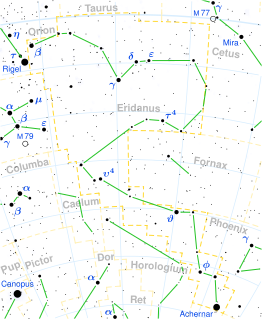 W
W40 Eridani, also designated Omicron² Eridani, is a triple star system in the constellation of Eridanus. Based on parallax measurements taken during the Hipparcos mission, it is less than 17 light-years from the Sun.
 W
W41 Arietis is a triple star system in the northern constellation of Aries. With an apparent visual magnitude of 3.63, this system is readily visible to the naked eye. It has an annual parallax shift of 19.69 mas, which indicates it is at a distance of 166 light-years from the Sun.
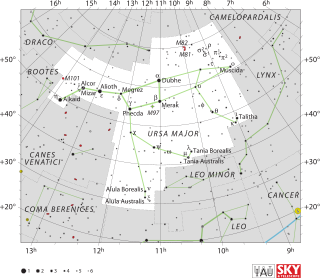 W
W41 Lyncis, also designated HD 81688 and named Intercrus, is a fifth magnitude star located in the northern constellation of Ursa Major. An extrasolar planet is thought to be orbiting the star.
 W
W42 Draconis, formally named Fafnir, is a 5th magnitude K-type giant star located approximately 315 light years away in the constellation of Draco. As of 2009, an extrasolar planet is thought to be orbiting the star.
 W
W42 Herculis is a single star located around 450 light years away from the Sun in the northern constellation of Hercules. It is visible to the naked eye as a faint, red-hued star with an apparent visual magnitude of 4.86. The star is moving closer to the Earth with a heliocentric radial velocity of −56 km/s.
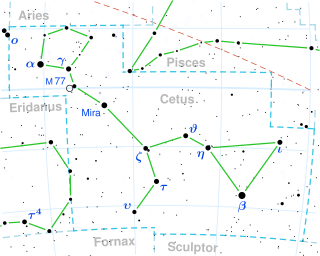 W
W49 Ceti is a single star in the equatorial constellation of Cetus. It is visible to the naked eye as a dim, white-hued star with an apparent visual magnitude of 5.607. The star is located 186 light-years away from the Solar System, based on its parallax, and is drifting further away with a radial velocity of +10 km/s. 49 Ceti has been identified as a member of the 40-million-year-old Argus Association.
 W
W51 Andromedae, abbreviated 51 And and formally named Nembus, is the 5th brightest star in the northern constellation of Andromeda, very slightly dimmer than the Andromeda Galaxy also being of 4th magnitude. It is an orange K-type giant star with an apparent magnitude of +3.59 and is about 169 light-years from the Earth/solar system. It is traditionally depicted as one of the two northern, far upper ends of the mythological, chained-to-the-rocks princess, the other being binary star system Gamma Andromedae.
 W
W54 Ceti is an older Flamsteed designation for a star that is now located within the constellation boundaries of Aries, the Ram. In the present day it is known by star catalogue identifiers like HD 11257 or HR 534. At an apparent visual magnitude of 5.94, it can be seen with the naked eye. The distance to this star, as determined using parallax measurements made during the Hipparcos mission, is approximately 139 light-years, give or take a 6 light-year margin of error. It is located near the ecliptic and hence is subject to occasional occultation by the Moon.
 W
W54 Piscium is an orange dwarf star approximately 36 light-years away in the constellation of Pisces. In 2003, an extrasolar planet was confirmed to be orbiting the star, and in 2006, a brown dwarf was also discovered orbiting it.
 W
W55 Persei is a single, blue-white hued star in the northern constellation Perseus. It is faintly visible to the naked eye under good seeing conditions, having an apparent visual magnitude of 5.73. Based upon an annual parallax shift of 8.50±0.38 mas as seen from Earth's orbit, the star is located about 380 light years from the Sun. At that distance, the visual magnitude is diminished by an extinction of 0.39 due to interstellar dust.
 W
W60 Andromedae is a star system in the northern constellation of Andromeda, located to the west-northwest of Gamma Andromedae. 60 Andromedae is the Flamsteed designation though the star also bears the Bayer designation b Andromedae. It is bright enough to be seen by the naked eye with an apparent visual magnitude of 4.82. Based upon parallax measurements made during the Hipparcos mission, it is at a distance of roughly 530 light-years from Earth.
 W
W63 Aurigae is a single star located around 395 light years away from the Sun in the northern constellation of Auriga. It is visible to the naked eye as a faint, orange-hued star with an apparent magnitude of 4.91. It is moving closer to the Earth with a heliocentric radial velocity of −28 km/s.
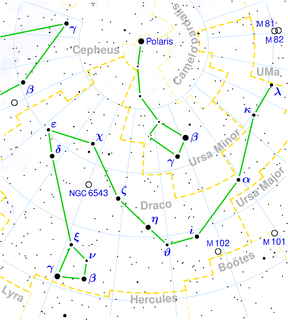 W
W64 Draconis is a single star in the northern circumpolar constellation of Draco, located 452 light years away. It has the Bayer designation of e Draconis; 64 Draconis is the Flamsteed designation. The object is visible to the naked eye as a dim, red-hued star with an apparent visual magnitude of 5.27. It is moving closer to the Earth with a heliocentric radial velocity of −36 km/s, and it is predicted to come as close as 204 ly in around 4.3 million years.
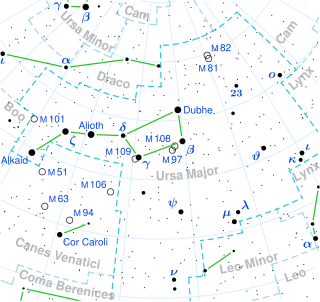 W
W65 Ursae Majoris, abbreviated as 65 UMa, is a star system in the constellation of Ursa Major. With an apparent magnitude of about 6.5, it is at the limit of human eyesight and is just barely visible to the naked eye. Trigonometric parallax measurements made by the Hipparcos spacecraft put it at a distance of about 690 light years ; this is in close agreement with the dynamical parallax value of 763 ± 95 light-years (234 ± 29 pc).